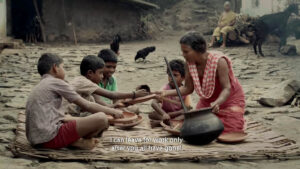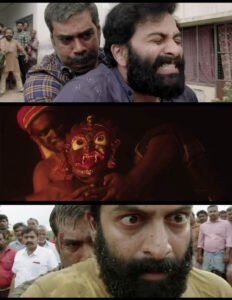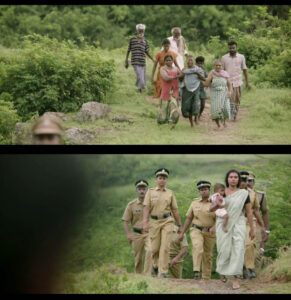Jaya Thampi revisits Sachy’s Ayyappanum Koshiyum (2020) to explore its cinematic soundscape and the many lives of Nanjiyamma’s songs in and beyond the film.
Jaya Thampi
The video of the song Kalakkatha from Ayyappanum Koshiyum (AK) became an instant hit when it was released on YouTube a week before the film’s release in 2020. In the video, we see a lone woman, Nanjiyamma, walking in the forest with her dog, grazing sheep, feeding hens, talking to her cat, near her house surrounded by trees, cooking and running other chores, intercut with visuals from the film, and her singing in the studio, leading a group of musicians from Attappadi gearing up with their instruments,1 being instructed by Jakes Bejoy, the film’s music director. It is almost as if viewers are introduced to the film through her; each snippet of the film on YouTube has her appealing voice, a voice that locates the story in Attappadi through which Nanjamma leads the viewers. The new media has marvelled at Nanjiyamma’s life before and after AK, and her ‘overnight stardom’ after her song went viral, and later won her the National Award for Best Playback Singer. Can we take a closer look at Nanjiyamma, and through her, the many lives of her songs in and beyond AK?
People unanimously welcomed the new singer and celebrated her song along with her innocence and lack of pretension. Kalakkatha’s video ends with the actor Prithviraj, who plays protagonist Koshi in AK, asking Nanjiyamma if she knows him, to which she replies in the negative. When asked whether she knew for which film she sang the song, she replies, ‘Mine?’ Nanjiyamma’s answer is more than a naïve reply, considering that she both acted and sang in the 2015 film Aggedu Nayaga (The Mother Tongue)2 directed by Sindhu Sajan in association with Palakkad Jilla Panchayat’s Harisree Project, implemented to address issues of education in the district. Nanjiyamma’s songs were subtitled in the film so as to translate the cultural domain of Attappadi inhabitants’ everyday lives to the Malayali public. Later that year, she sang in the film Velutha Rathrikal by Razi Muhammed. She is also the lead singer of Azad Kala Samithi, a collective of Attappadi performing artists led by Pazhanisami, active for the last twenty years all over Kerala. Nevertheless, the last bit of ‘Kalakkatha’ marks her relationship with popular cinema; she mentions her love for films from a young age, and how she would finish all her chores early to reach the cinema kottaka (theatre), although she hardly gets to see any now.

Songs and Sounds That Travel with Nanjiyamma to AK’s Attappadi
In another interview, Nanjiyamma narrates the context of Kalakkatha: ‘The adults go to the fields as wage labourers, and the grandmothers in the hamlets are left with the kids—they cook and feed them while singing songs. I have known Kalakkatha, one such song, since I was thirteen. I feel that I only made this song, or maybe my grandmother’. Talking about the songs that came to her from the forests and her people, she reflects on her childhood days in Alamkandi Puthoor in Tamil Nadu, where she was the main singer for all the death ceremonies, and her life after marriage with Nanjiyappan, a porai artist who performs pakkamelam at the ooru (village), who encouraged her to take music beyond the Nakupathi ooru in Attappadi and perform for different audiences. ‘Muthaachis (older women other than pattis or grandmothers) in the house, who lived silent lives like caged birds, would go out only for rituals, to sing and dance in the social gatherings’. As women were forbidden to perform therukkuthu, a theatrical performance that accompanied the death ceremonies in the community, Nanjiyamma took great interest in watching her brother Kali perform ramarkuthu, kovilan koothu, harishchandran koothu and learnt the koothu songs.
In AK, Kalakkatha bridges the folkloric world of Mundoor Madan—the quasi-mythical and vengeful alter-ego of the sincere, empathetic Sub-Inspector Ayyappan (Biju Menon)—with the present-day Attappady with its modern-day concerns, and its own network of relationships between the state and citizens. It is into this space that Koshi enters—an arrogant outsider whose experience with the public is limited to his time in the military and interactions with influential politicians—from a rich, feudal Christian household of an authoritative father in Kattappana. After a cycle of mutual provocation that ends in his suspension from the police department, Ayyappan becomes freed from state control. The film comments on ‘wildness’ and ‘humanness’, and how these qualities manifest at the same time in two characters from disparate socioeconomic backgrounds, whose will to win over the other poses a challenge to the state. In this process of overpowering (thalakkuka3) each other, they end up taming and disciplining each other, like thappaanas.4 This chain of events without a clear resolution is captured and highlighted by the layered, cyclical musical soundscape of the film. ‘Folk music’ is conventionally characterised by its tempo, rhythm, and repetition of lyrical phrases and vaitharis (oral rhythms). While the plot and narrative of AK call for the use of folk aesthetics, repetition being part of it thematically, the music enhances the meanings of each sequence. It also challenges similar formalistic definitions of music by developing each song as a solo performance within and outside the narrative, turning folk singers like Nanjiyamma into (more than) playback singers.
In the film, the song of Kummatti, ‘Ponnambike Devi’, appears with every strangling grip of Ayyappan. Jakes Bejoy makes slight changes in the original soundtrack, escalating the mood of terror. Before the title sequence, the entry of a young Ayyappan disguised in kummattikolam, as a vigilante assassin on the side of ‘the Harijan comrades’,5 is accompanied by an elephant’s trumpet, a symbolic suggestion of the repressed ‘wildness’ in the character, as he strangles the ‘Pandi’ thugs (also disguised in kummattikolam) brought by the landlords to finish off the rebels. In the climax, when the grasp is broken by the police, this music fades out to silence, which is then broken by the sound of trumpet and drums, reminiscent of a police parade, as the pacified Ayyappan, reassured of Kannamma’s (an Adivasi activist and Ayyappan’s wife, played by Gowri Nandha) return, accepts his reinstatement to the department. After the climactic confrontation, both return to where they belong—Koshi to his disciplinarian father, with a renewed sense of authority, and Ayyappan to the state—each back to their own tutelage. The film suspends the final punishment (Koshi’s death by Mundoor Madan) and sustains the suspense even after resolving the conflict, as a resolute Ayyappan returns to Koshi almost as if he can make sense of himself only against Koshi.

Kannamma in The Soundscape of AK
What is the female soundscape doing in a film based on the clash of male egos? What starts as a fight between two men is sustained with fresh triggers that involve the women in their families. But it is not the familiar trope of women’s violation6 that is employed here. In the film, Kannamma is the first to outwardly condemn Koshi. When she commands Ayyappan to teach Koshi a lesson after verbally emasculating Koshi, we hear the kuzhal (a wind instrument popular among the Irulars in Attappadi) in the background, blending with the bleat of the goats and the child’s cry from the cradle. Free and fierce, Kannamma becomes the antithesis of Ruby, Koshi’s wife who lives a servile existence in a big house. For her, Koshi is no more than a reckless snobbish youth, one among many men she may have encountered as an activist.
By establishing Nanjiyamma as Kannamma’s mother, it becomes difficult to separate the singer from the narrative. Further, Nanjiyamma’s own identity as an Irula singer from Attappadi adds meaning to the film. In AK, Nanjiyamma not only comes out as a playback singer but is also at the forefront of the film. The narrative establishes the voice as her own; Kalakkatha is neither lip-synced to any particular character nor played as a chorus complementing a real vocal performance. It is in itself a full-fledged solo performance, a song made and sung by Nanjiyamma; in the film, it emanates from Attappadi. We have a singer, introduced to the larger public as she is, even in a staged cinematic act, contrary to the previous representation of the Adivasis in popular cinema.
By adding reverb in the mournful, lullaby-like ‘Deivamakale’, Jakes presents the song as a solo without any percussion, capturing the feeling of loss as is experienced by the mother (who, here, is the singer herself) when her daughter is taken in custody. The song, originally created by Nanjiyamma from her experience of a personal loss, not just allows for instant identification with Kannamma in the narrative but becomes central to the film’s identity itself. As director Sachy once remarked to Jakes hearing her sing for the first time, ‘This is my Kannamma, this is the voice of Ayyappanum Koshiyum!’ When superimposed with a stoic Kannamma, resolute in her convictions as she takes along her child when arrested, the song also brings out an effect opposed to that of melodrama, by highlighting this contrast, even with Koshi, who breaks down in tears as he hugs his children in jail.

‘Adakachakka’, conventionally sung during the death ceremonies of the Irulas, comes for the first time when Ayyappan casually boards down the bus to mete out justice by himself by destroying Kuttamani’s (Sabumon) shop with a JCB, a show of his strength in front of Koshi. The song of death reappears in the climactic fight sequence where neither of the protagonists dies. Despite being a death song, ‘Adakkachakka’ is fierce, while remaining pleasant in the mood it creates. Nanjiyamma explains the community logic of mourning the loss by sending their loved ones happily from the earth, by singing and dancing for them. While the song provided the background score in the movie where the fight sequence is the major entertainment, it became a meeting point of both these logics.
The Many Lives of Nanjiyamma’s Songs Beyond AK
When Nanjiyamma becomes a character in the soundscape she creates by placing her own identity in it and creating the soundscape around it, we can also see how her songs have travelled beyond their beginnings. A month after Kalakkatha was released on YouTube, Nanjiyamma became the face of Kerala Life Mission’s promotion video song in Irulabhasha, translated as ‘(the government) did not ask them their caste, or religion, or citizenship but (the government) saw them as one’, tuned like ‘Deivamakale’ but without the pathos and in a faster rhythm. When ‘Deivamakale’ was released on YouTube as a tribute video for director Sachy after his death, the feeling of the bereavement embedded in the song was carried over into it. The popularity of ‘Kalakkatha’ has also to do with its rhythm, and how it could be played as dance-music, of which the most popular one was the Kerala police’s corona awareness dance video. The rhythm and slogan-like quality of the melody formed the basis for Soumya Sanathanan’s ode to womanhood, mixed with live sounds of women’s household activities along with studio-recorded sounds of spoons and vessels. Another of Nanjiyamma’s songs, ‘Thina Thinthina‘, composed by Gopi Sundar for a television serial, is now remixed as a dance song. Each instance marks the peculiar route the songs take from where they started. Who would have imagined that more than a million people would watch Kerala police dance to a popular song in Nanjiyamma’s ooru, sung for distracting kids with ‘the flowers of sandalwood trees’ and ‘aeroplanes’ to feed them?
In the after-life of AK, we find vloggers travelling to Attappadi to meet Nanjiyamma and talk about her music and fame, life experiences, cuisines and culture. The number of vlogs has only increased after she won the National Award, twelve years after she won the Kerala Folklore Award (as mentioned by V H Dirar in Nanjamma Enna Pattamma, Nanjiyamma’s biography). Even the discussions that followed this historic moment emphasised the need to recognize Nanjiyamma’s music as a distinct form and on the same pedestal as any other music. Apart from challenging the cultural hegemony of classical or popular music in a culture industry with less number of Dalits and Adivasis as playback singers, this moment reassured the folk artists of their worth and dignity in practising the art, and the possibility of using folk aesthetics creatively in popular cinema, its potential to add to meaning-making within the narrative as well as to exist as a stand-alone song, remixed or re-interpreted in different contexts.
About the Author: Jaya is pursuing her PhD in Cultural Studies at The English and Foreign Languages University, Hyderabad. Caste, music, and popular culture are some of her research interests. You can find her on Instagram here.
Editor’s Note: This article is one of six articles written by participants from our 2022 Writing Workshop, and part of Ala’s fourth-anniversary specials: Issue 49 and Issue 50.
